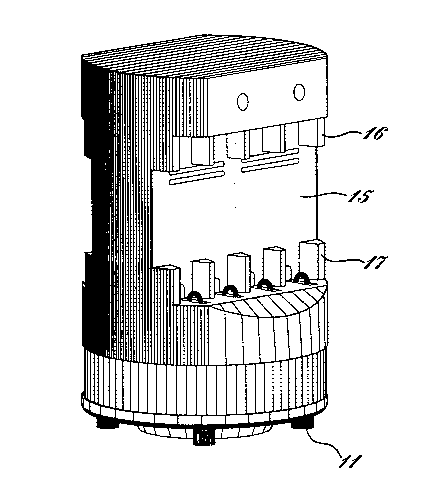Une partie des informations de ce site Web a été fournie par des sources externes. Le gouvernement du Canada n'assume aucune responsabilité concernant la précision, l'actualité ou la fiabilité des informations fournies par les sources externes. Les utilisateurs qui désirent employer cette information devraient consulter directement la source des informations. Le contenu fourni par les sources externes n'est pas assujetti aux exigences sur les langues officielles, la protection des renseignements personnels et l'accessibilité.
L'apparition de différences dans le texte et l'image des Revendications et de l'Abrégé dépend du moment auquel le document est publié. Les textes des Revendications et de l'Abrégé sont affichés :
| (12) Demande de brevet: | (11) CA 2128853 |
|---|---|
| (54) Titre français: | CHARGEUR POUR PILES CYLINDRIQUES |
| (54) Titre anglais: | BATTERY CHARGER FOR CYLINDRICAL BATTERIES |
| Statut: | Réputée abandonnée et au-delà du délai pour le rétablissement - en attente de la réponse à l’avis de communication rejetée |
| (51) Classification internationale des brevets (CIB): |
|
|---|---|
| (72) Inventeurs : |
|
| (73) Titulaires : |
|
| (71) Demandeurs : |
|
| (74) Agent: | SMART & BIGGAR LP |
| (74) Co-agent: | |
| (45) Délivré: | |
| (22) Date de dépôt: | 1994-07-26 |
| (41) Mise à la disponibilité du public: | 1995-08-05 |
| Licence disponible: | S.O. |
| Cédé au domaine public: | S.O. |
| (25) Langue des documents déposés: | Anglais |
| Traité de coopération en matière de brevets (PCT): | Non |
|---|
| (30) Données de priorité de la demande: | ||||||
|---|---|---|---|---|---|---|
|
Battery charger for cylindrical cells which comprises a
substantially cylindrical housing with respective bottom and
upper parts separated by a pair of opposing recesses. In
operation the housing is arranged in upright position and
the recesses have planar rear faces extending in parallel
with each other and with the axis of symmetry of the hous-
ing. Spaced guiding ribs are provided at upper and lower end
zones of the faces to laterally guide the cells to be in-
serted. Contact members are arranged at upper and lower end
walls of the recesses between the ribs to spring-bias the
cells inserted. The bottom part is capable of locating a
mains transformer. Slots are defined in lower and upper
parts of the housing which define an airflow cooling
channel.
Note : Les revendications sont présentées dans la langue officielle dans laquelle elles ont été soumises.
Note : Les descriptions sont présentées dans la langue officielle dans laquelle elles ont été soumises.

2024-08-01 : Dans le cadre de la transition vers les Brevets de nouvelle génération (BNG), la base de données sur les brevets canadiens (BDBC) contient désormais un Historique d'événement plus détaillé, qui reproduit le Journal des événements de notre nouvelle solution interne.
Veuillez noter que les événements débutant par « Inactive : » se réfèrent à des événements qui ne sont plus utilisés dans notre nouvelle solution interne.
Pour une meilleure compréhension de l'état de la demande ou brevet qui figure sur cette page, la rubrique Mise en garde , et les descriptions de Brevet , Historique d'événement , Taxes périodiques et Historique des paiements devraient être consultées.
| Description | Date |
|---|---|
| Inactive : CIB de MCD | 2006-03-11 |
| Inactive : CIB de MCD | 2006-03-11 |
| Le délai pour l'annulation est expiré | 2000-07-26 |
| Demande non rétablie avant l'échéance | 2000-07-26 |
| Réputée abandonnée - omission de répondre à un avis sur les taxes pour le maintien en état | 1999-07-26 |
| Demande publiée (accessible au public) | 1995-08-05 |
| Date d'abandonnement | Raison | Date de rétablissement |
|---|---|---|
| 1999-07-26 |
Le dernier paiement a été reçu le 1998-07-07
Avis : Si le paiement en totalité n'a pas été reçu au plus tard à la date indiquée, une taxe supplémentaire peut être imposée, soit une des taxes suivantes :
Les taxes sur les brevets sont ajustées au 1er janvier de chaque année. Les montants ci-dessus sont les montants actuels s'ils sont reçus au plus tard le 31 décembre de l'année en cours.
Veuillez vous référer à la page web des
taxes sur les brevets
de l'OPIC pour voir tous les montants actuels des taxes.
| Type de taxes | Anniversaire | Échéance | Date payée |
|---|---|---|---|
| TM (demande, 3e anniv.) - petite | 03 | 1997-07-28 | 1997-07-25 |
| TM (demande, 4e anniv.) - petite | 04 | 1998-07-27 | 1998-07-07 |
Les titulaires actuels et antérieures au dossier sont affichés en ordre alphabétique.
| Titulaires actuels au dossier |
|---|
| PURE ENERGY BATTERY CORPORATION |
| Titulaires antérieures au dossier |
|---|
| ROBERT FLACK |